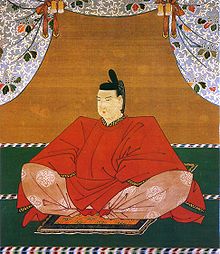Loading AI tools
Emperor of Japan From Wikipedia, the free encyclopedia
Emperor Ichijō (一条天皇, Ichijō-tennō, July 15, 980 – July 25, 1011) was the 66th emperor of Japan,[1] according to the traditional order of succession.[2]
| Emperor Ichijō 一条天皇 | |||||
|---|---|---|---|---|---|
 | |||||
| Emperor of Japan | |||||
| Reign | July 31, 986 – July 16, 1011 | ||||
| Enthronement | August 1, 986 | ||||
| Predecessor | Kazan | ||||
| Successor | Sanjō | ||||
| Born | July 15, 980 Heian Kyō (Kyōto) | ||||
| Died | July 25, 1011 (aged 31) Heian Kyō (Kyōto) | ||||
| Burial | En'yū-ji no kita no misasagi (圓蝠寺北陵) (Kyoto) | ||||
| Spouses | |||||
| Issue |
| ||||
| |||||
| House | Imperial House of Japan | ||||
| Father | Emperor En'yū | ||||
| Mother | Fujiwara no Senshi [ja] | ||||
Ichijō's reign spanned the years from 986 to 1011.[3]
Before he ascended to the Chrysanthemum Throne, his personal name (imina) was Yasuhito-shinnō (懐仁).[4] Kanehito-shinnō was the first son of Emperor En'yū and Fujiwara no Senshi, a daughter of Fujiwara no Kaneie. Since there are no documented siblings, it is supposed that he was an only child.
Ichijō had five Empresses or Imperial consorts and five Imperial sons and daughters.[5]
His reign coincided with the culmination of Heian period culture and the apex of the power of the Fujiwara clan. He ascended to the throne after a period of political instability that began within the Fujiwara clan after they successfully eliminated the Minamoto clan as a political rival. The internal power struggle that ensued within the Fujiwara saw the untimely ends of three emperors. Ichijō had been appointed crown prince under Emperor Kazan in 984.[6] Two years later, after Emperor Kazan abdicated in 986, Ichijō ascended to the throne at the age of six. The young Emperor Ichijō was under the influence of his uncle Fujiwara no Michinaga from the start of his reign,[7] though Michinaga's true ascent to political dominance did not begin until 995 after the deaths of his older brothers and the exile of his political rival and nephew, Korechika.[8]
These events took place during the Kanna era (see Japanese era name nengō 年号), after Emperor Kazan abdicated. The succession (senso) was received by a cousin, the son of his father's younger brother.[9]
A son of Emperor Reizei, who was older than Ichijō, was appointed crown prince. Kaneie became the regent (Sesshō) and effectively ruled the state. After Kaneie died in 990, his first son and Ichijō's uncle Fujiwara no Michitaka was appointed regent.
The mother of the emperor had a large influence over the appointment of officials, "the emperor's officials controls matters of the state, as the imperial mother makes affairs of the court solely her own."[14]
Ichijō had two empress consorts. First was Teishi (or Fujiwara no Sadako), a daughter of Fujiwara no Michitaka. Second was Shōshi (or Akiko), a daughter of Fujiwara no Michinaga, a younger brother of Michitaka. Most people thought it impossible to have two empress consorts, but Michinaga claimed that the empress held two separate titles, Chūgū and Kōgō, which were different in principle and could therefore given to two different women.
The courts of both empresses were known as centers of culture. Sei Shōnagon, author of The Pillow Book, was a lady in waiting to Teishi. Murasaki Shikibu was a lady in waiting to Shoshi. There were other famous poets in the courts of the empresses.
Ichijō loved literature and music. For this reason, high ranked courtiers felt the necessity for their daughter to hold cultural salons with many skillful lady poets. Particularly he was fond of the flute. Ichijō was known for his temperate character and was beloved by his subjects.
During Ichijō's reign, Imperial visits were first made to the following four shrines: Kasuga, Ōharano, Matsunoo, and Kitano; and in the years which followed, Emperors traditionally made yearly Imperial visits to these shrines and to three others: Kamo, Iwashimizu and Hirano.[15]

The actual site of Ichijō's grave is known.[1] This emperor is traditionally venerated at a memorial Shinto shrine (misasagi) at Kyoto.
The Imperial Household Agency designates this location as Ichijō's mausoleum. It is formally named En'yū-ji no kita no misasagi.[16]
Ichijō is buried amongst the "Seven Imperial Tombs" at Ryōan-ji Temple in Kyoto.[17] The mound which commemorates the Emperor Ichijō is today named Kinugasa-yama. The emperor's burial place would have been quite humble in the period after Ichijo died.
These tombs reached their present state as a result of the 19th century restoration of imperial sepulchers (misasagi) which were ordered by Emperor Meiji.[18]
Kugyō (公卿) is a collective term for the very few most powerful men attached to the court of the Emperor of Japan in pre-Meiji eras.
In general, this elite group included only three to four men at a time. These were hereditary courtiers whose experience and background have brought them to the pinnacle of a life's career.
During Kazan's reign, this apex of the Daijō-kan included:
The years of Ichijō's reign are more specifically identified by more than one era name or nengō.[22]
| Ancestors of Emperor Ichijō | |||||||||||||||||||||||||||||||||||||||||||||||||||||||||||||||||||||||||||||||||||||||||||||||||||||||||||||||||||||||||||||||||||||||||||||||||||||||||||||||||||||||||||||||||||||||||||||||||||||||||||||||||||||||||||||||||||||||||||||||||||||||||||||||||||||||||||||||||||||||||
|---|---|---|---|---|---|---|---|---|---|---|---|---|---|---|---|---|---|---|---|---|---|---|---|---|---|---|---|---|---|---|---|---|---|---|---|---|---|---|---|---|---|---|---|---|---|---|---|---|---|---|---|---|---|---|---|---|---|---|---|---|---|---|---|---|---|---|---|---|---|---|---|---|---|---|---|---|---|---|---|---|---|---|---|---|---|---|---|---|---|---|---|---|---|---|---|---|---|---|---|---|---|---|---|---|---|---|---|---|---|---|---|---|---|---|---|---|---|---|---|---|---|---|---|---|---|---|---|---|---|---|---|---|---|---|---|---|---|---|---|---|---|---|---|---|---|---|---|---|---|---|---|---|---|---|---|---|---|---|---|---|---|---|---|---|---|---|---|---|---|---|---|---|---|---|---|---|---|---|---|---|---|---|---|---|---|---|---|---|---|---|---|---|---|---|---|---|---|---|---|---|---|---|---|---|---|---|---|---|---|---|---|---|---|---|---|---|---|---|---|---|---|---|---|---|---|---|---|---|---|---|---|---|---|---|---|---|---|---|---|---|---|---|---|---|---|---|---|---|---|---|---|---|---|---|---|---|---|---|---|---|---|---|---|---|---|---|---|---|---|---|---|---|---|---|---|---|---|---|---|---|---|
| |||||||||||||||||||||||||||||||||||||||||||||||||||||||||||||||||||||||||||||||||||||||||||||||||||||||||||||||||||||||||||||||||||||||||||||||||||||||||||||||||||||||||||||||||||||||||||||||||||||||||||||||||||||||||||||||||||||||||||||||||||||||||||||||||||||||||||||||||||||||||
Seamless Wikipedia browsing. On steroids.
Every time you click a link to Wikipedia, Wiktionary or Wikiquote in your browser's search results, it will show the modern Wikiwand interface.
Wikiwand extension is a five stars, simple, with minimum permission required to keep your browsing private, safe and transparent.